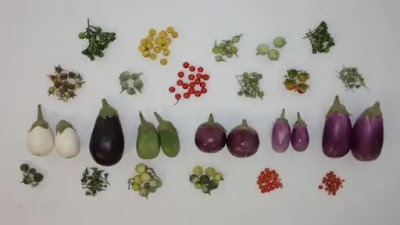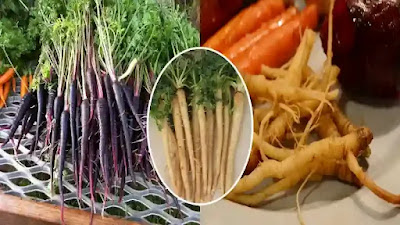What did vegetables and fruits look like before they were hybridized?
Hybridization, in short, is the process of cross-pollination between different plant species conducted by humans. This process ultimately leads to significant changes in the taste, shape, or color of the original plant.
Throughout history, humans have used hybridization to improve agricultural crops, to the extent that some fruits and vegetables have completely transformed from their original appearance!
Vegetables and fruits completely change their appearance from before
The eggplant is known for its distinctive deep purple-black color, and if not black, it appears in a white variety. However, when observing wild eggplants, we find that their shape and color resemble that of a tomato. In fact, this is the only natural color of eggplants that still exists today.
Throughout history, for thousands of years, humans have mastered agriculture and its various techniques. One of the most important methods has been hybridization, as mentioned earlier. Through this process, humans have been able to select the best crops and combine them during cultivation to achieve superior varieties.
Over time, hybridization led to improved crop quality and increased yields. However, a side effect of this process was the gradual disappearance of the original wild varieties. Wild eggplants once existed in various colors and shapes, and some even had thorns. But through selective breeding, farmers prioritized larger, fleshier fruits with fewer thorns. Eventually, eggplants evolved into the familiar form we know today. As the years passed, many of the thorny, wild varieties gradually became extinct.
Carrots are known for their bright orange color, but in the past, they looked quite different. Originally, all carrot varieties ranged in color from white to brown to purple. The wild ancestor of modern carrots was thin, with more fibrous strands than actual roots. However, despite its appearance, it had a much stronger flavor and a naturally sweet taste.
The main drawback of this wild carrot variety was its low yield, despite its rich and distinctive flavor. Those who have tasted purple carrots know that they are much more flavorful. Although commercial production of these varieties has largely ceased, some wild carrot species still exist today.
Historians believe that the hybridization of wild carrot varieties began in ancient Greece, Persia, and Rome. Additionally, some historians suggest that the dominance of the orange carrot we know today is specifically due to selective breeding by Dutch farmers in the 17th century.
The painting before you is by the Italian artist Giovanni Stanchi, created in the 17th century. It depicts a watermelon with an unusual appearance. The vibrant red flesh that we all love today was not common in ancient watermelons. Even the seeds were far more abundant than they are now. This painting serves as a record of the changes that occurred in watermelons by the 17th century, where they appeared divided into six distinct sections.
Researchers believe that the original watermelon varieties were first hybridized in Egypt and Libya thousands of years ago. At that time, watermelons were smaller in size and contained far more seeds compared to the modern varieties we see today.
Bananas are a unique case in the process of hybridization. Through the blending of genetic traits from two different wild plant species, a completely new fruit emerged—the familiar yellow banana. Researchers believe that the original wild bananas were first hybridized in Southeast Asia and China thousands of years ago.
The familiar yellow banana, favored by many, is the final result of a long process of hybridization and improvement that took many years. The original banana, upon which this hybridization took place, was a green fruit with little sugar and filled with seeds. Two different plant species were crossbred to create it.
The first species, known as *Musa acuminata*, is described by researchers as a plant covered with small thorns, resembling the okra we know today. The second species, *Musa balbisiana*, resembled small green bananas, but was filled with large, hard seeds.
Over the years, banana hybridization led to the emergence of two main varieties among ancient farmers: *Gros Michel* and *Cavendish*. Since *Gros Michel* was easier to cultivate and had a better taste, it dominated the markets, while *Cavendish* had little popularity in both markets and farms.
However, a fungal disease emerged that devastated the *Gros Michel* variety, forcing farmers to switch to the *Cavendish* variety, which is the one most commonly known today.
This situation has raised concerns among many research teams, as the *Cavendish* banana is also susceptible to a disease that could eventually wipe it out. As a result, experiments are underway to develop a completely new type of banana as a precaution.
Corn is one of the most cooperative crops when it comes to seed hybridization. Thousands of years ago, farmers in Mexico began selecting the best seeds from the *teosinte* plant, a grassy plant that still exists today. This plant somewhat resembled wheat ears and consisted of small, hard seeds arranged in several rows. Its taste was somewhat similar to raw potato.
Over the years, the crop began to change in both shape and taste, until farmers were able to stabilize a variety that met their expectations. This led to the modern form and taste of corn that we recognize today. Researchers note that this transformation began in the 15th century and has remained unchanged to the present day.
Red, green, and yellow apples are favorites for many, and according to researchers, they are descendants of four original apple varieties. Ancient farmers used to crossbreed these varieties to inherit the best traits from each one. To this day, two of these wild apple species can still be found in the region where the modern apple originated.
This area, currently spanning Kazakhstan, Tajikistan, Uzbekistan, and surrounding regions, is home to two of these wild varieties: *Malus sieversii*, which resembles a guava or pomegranate, and another variety called *Granny Smith*, which closely resembles the apples we know today.
These fruits are found in the aforementioned mountains and are highly favored by animals, especially bears. Their taste is still considered acceptable today, though they contain less sugar than the hybrid apples we eat now. Additionally, their harvest is quite rare, lasting only two months each year. As a result, over the past 4,000 years, humans have primarily used these two varieties in hybridization processes to produce the apples we are familiar with today.
Tomatoes are considered a relatively recent plant in the world, especially in the Arab world. The original tomatoes were herbaceous plants that produced small, yellow fruits resembling cherry tomatoes. Through hybridization, they gradually began to take the shape and appearance that we recognize today.
Tomatoes spread globally after the Spanish armies began entering the New World and encountered the Aztec civilization in the 16th century. Prior to that, tomatoes were unknown in the other continents. They eventually made their way to the Middle East through Egypt, Turkey, and the Levant in the late 19th century.
Despite its widespread popularity today and its inclusion in nearly every type of cooked dish, the tomato's fame was delayed due to an issue that arose when it was first planted in Europe. It became contaminated with certain substances, including lead, which caused numerous cases of poisoning and death. As a result, a belief emerged that this plant was toxic.
The delicious peach, thousands of years ago, was small in size, had a salty taste, very little juice, and a large inner seed. However, through the hybridization efforts of ancient farmers from the Himalayan regions, the peach transformed into the familiar shape and taste that we know today.
Rich in nutrients, this did not stop the continued cultivation of wild peaches, which are now used to extract oils. These oils have many therapeutic and culinary applications.











